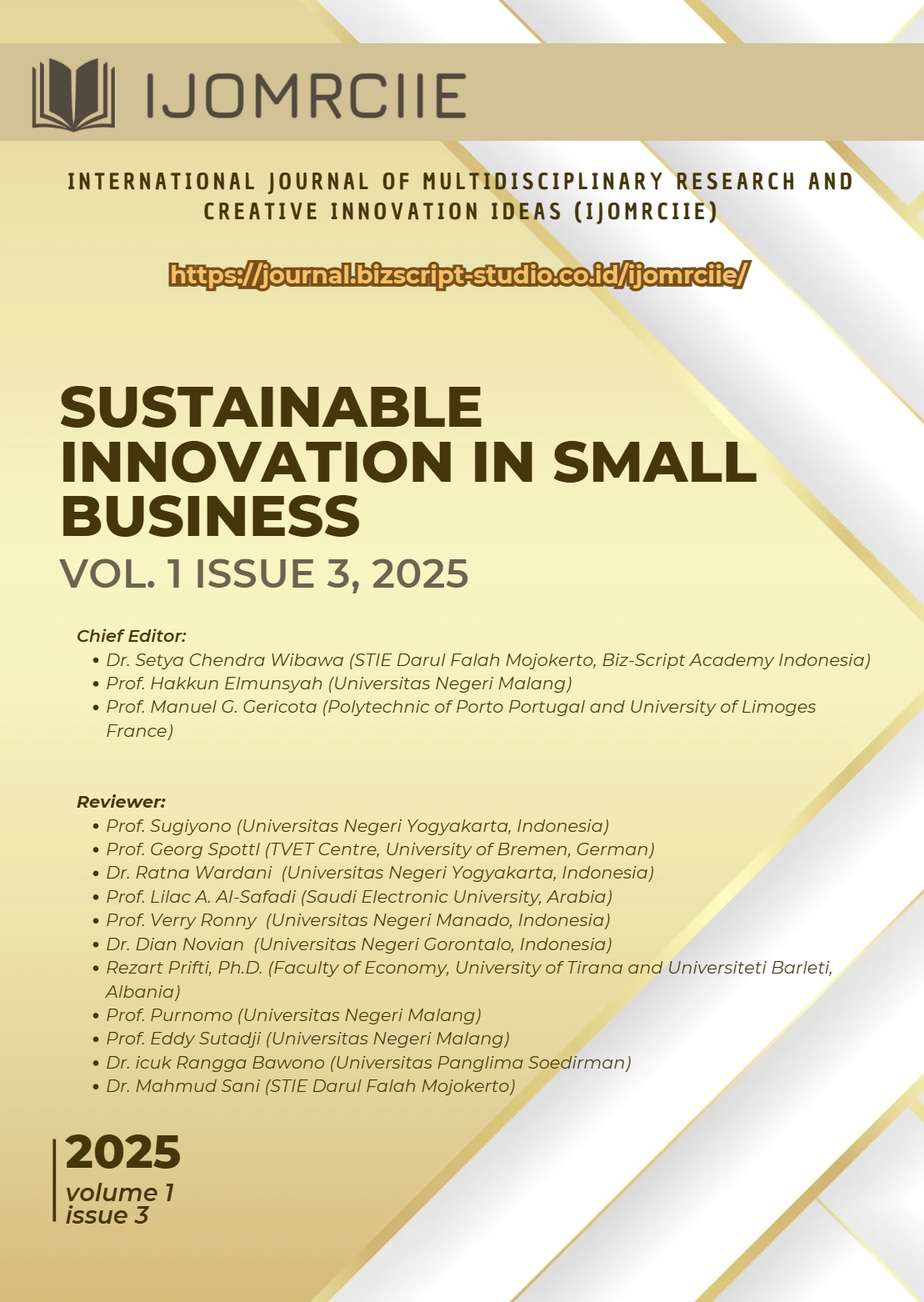Circular Economy Readiness Mediation Analysis on the Relationship between Green Innovation and Sustainable Development Goals (SDGs) in Indonesia
Keywords:
Mediation Analysis, Circular Economy, Readiness, Green Innovation, SDGsAbstract
Sustainable development in Indonesia is highly dependent on the effective implementation of green innovation as an effort to achieve the Sustainable Development Goals (SDGs). However, this success is greatly influenced by the readiness of the circular economy readiness which is the main mediator in the relationship between green innovation and the achievement of the SDGs. Challenges faced include the readiness of human resources and skills, lack of coordination and collaboration between stakeholders, and complexity in the measurement and mediation analysis of these factors. This study aims to analyze the mediating role of circular economy readiness in the relationship between green innovation and SDGs in Indonesia. The research method uses a quantitative approach with mediation analysis through the Partial Least Squares Structural Equation Modeling (PLS-SEM) technique. Data was collected through a survey with a sample of 170 respondents representing various sectors related to green innovation and the circular economy in Indonesia. Data collection was carried out by distributing questionnaires directly and online, then analyzed using the PLS-SEM model to test the role of mediation in the concept model. The results show that circular economy readiness significantly mediates a positive relationship between green innovation and the achievement of the SDGs. This indicates that increasing the readiness of the circular economy can strengthen the contribution of green innovation in achieving sustainable development goals. The findings also highlight the importance of increasing human resource capacity and increasing synergy between stakeholders to overcome the complexity of measurement and analysis. The conclusion of this study emphasizes that the readiness of the circular economy is a key factor that supports the acceleration of the achievement of the SDGs through green innovation. The practical implication is the need for policies and programs that strengthen human resource capabilities and cross-sector collaboration to realize a sustainable green economy in Indonesia
Downloads
References
Analisis, P. (n.d.). ANALISIS DATA PENELITIAN.
Chan, T. J. (2025). Perceived Circular Economy as a Mediator between Green Advertising and Circular Buying Behavior. Journal of Environmental Management.
Durakbasa, N. M., & Gülen, K. G. (Eds.). (2025). 24th International Symposium for Production Research, ISPR 2024. Lecture Notes in Mechanical Engineering. https://www.scopus.com/inward/record.uri?eid=2-s2.0-105005337803&partnerID=40&md5=e9004c3312a56933957915370069d097
Khan, I. S., Ahmad, M. O., & Majava, J. (2023). Industry 4.0 innovations and their implications: An evaluation from sustainable development perspective. Journal of Cleaner Production, 405. https://doi.org/10.1016/j.jclepro.2023.137006
Khan, M. I., Yasmeen, T., Khan, M., Hadi, N. U., Asif, M., Farooq, M., & Al-Ghamdi, S. G. (2025). Integrating industry 4.0 for enhanced sustainability: Pathways and prospects. Sustainable Production and Consumption, 54, 149–189. https://doi.org/10.1016/j.spc.2024.12.012
Kirchherr, J., Reike, D., & Hekkert, M. (2017). Conceptualizing the circular economy: An analysis of 114 definitions. Resources, Conservation and Recycling, 127, 221–232.
Kuzmina, J., Vesere, R., Atstaja, D., Cudečka-Puriņa, N., & Purviņš, M. (2025). Evaluation of UN SDGs Achievements Considering the Eco-Innovations Metrics. Case: European Union Countries. 1, 319–323. https://doi.org/10.17770/etr2025vol1.8704
Lewandowski, M. (2016). Designing the business models for circular economy—Towards the conceptual framework. Sustainability, 8(1), 43.
Marcone, M. R. (2025). Sustainable supply chain in a new technological era: the case of the Italian agrifood sector. European Journal of Innovation Management, 28(11), 321–348. https://doi.org/10.1108/EJIM-04-2024-0421
Martínez, D. E., Slack, J. Y., & Martínez-Schuldt, R. (2018). Research methods. The Shadow of the Wall: Violence and Migration on the U.S.-Mexico Border, 18–42. https://doi.org/10.2307/j.ctvjsf6r5.12
Mehmood, K., Kautish, P., Sithipolvanichgul, J., & Gupta, P. (2025). Circular economy readiness and digital solutions: redefining urban sustainability through human-centered technological advancements. Technological Forecasting and Social Change, 219. https://doi.org/10.1016/j.techfore.2025.124242
Moorthy, K. S., Balakrishnan, G., Satheesh Kumar, S. S., Raja, L., & Vijayalakshmi, A. (2024). Embracing circular economy principles for sustainable green supply chain management in manufacturing industries (pp. 85–110). IGI Global. https://doi.org/10.4018/979-8-3693-1343-5.ch005
Munir, M. A., Habib, M. S., HUSSAIN, A., Shahbaz, M. A., Qamar, A., Masood, T., Sultan, M., Abbas, M. A., Imran, S., Hasan, M., Akhtar, M. S., Ayub, H. M., & Salman, C. A. (2022). Blockchain Adoption for Sustainable Supply Chain Management: Economic, Environmental, and Social Perspectives. Frontiers in Energy Research, 10. https://doi.org/10.3389/fenrg.2022.899632
Papachristou, E., & Bilalis, N. (2016). A new sustainable product development model in apparel based on 3D technologies for virtual proper fit. In R. Setchi, Y. Liu, P. Theobald, R. J. Howlett, & R. J. Howlett (Eds.), Smart Innovation, Systems and Technologies (Vol. 52, pp. 85–95). Springer Science and Business Media Deutschland GmbH info@springer-sbm.com. https://doi.org/10.1007/978-3-319-32098-4_8
Perwitasari, F. D., Anwar, S., Sapari, Y., & Suhana, S. (2025). Empowerment of female human resources towards the 2030 SDGs through the manufacture of traditional animal medicine in Gunungmanik Village. 02006.
Porter, M. E., & van der Linde, C. (1995). Toward a new conception of the environment-competitiveness relationship. Journal of Economic Perspectives, 9(4), 97–118.
Sachs, J. D., Schmidt-Traub, G., Kroll, C., Lafortune, G., & Fuller, G. (2019). Sustainable Development Report 2019. Bertelsmann Stiftung and Sustainable Development Solutions Network (SDSN).
Schiederig, T., Tietze, F., & Herstatt, C. (2012). Green innovation in technology and innovation management—An exploratory literature review. R&D Management, 42(2), 180–192.
Singh, B., & Yadav, A. K. (n.d.). THE IMPACT OF CULTURAL AND ECONOMIC FACTORS ON SOCIAL. 1–17.






